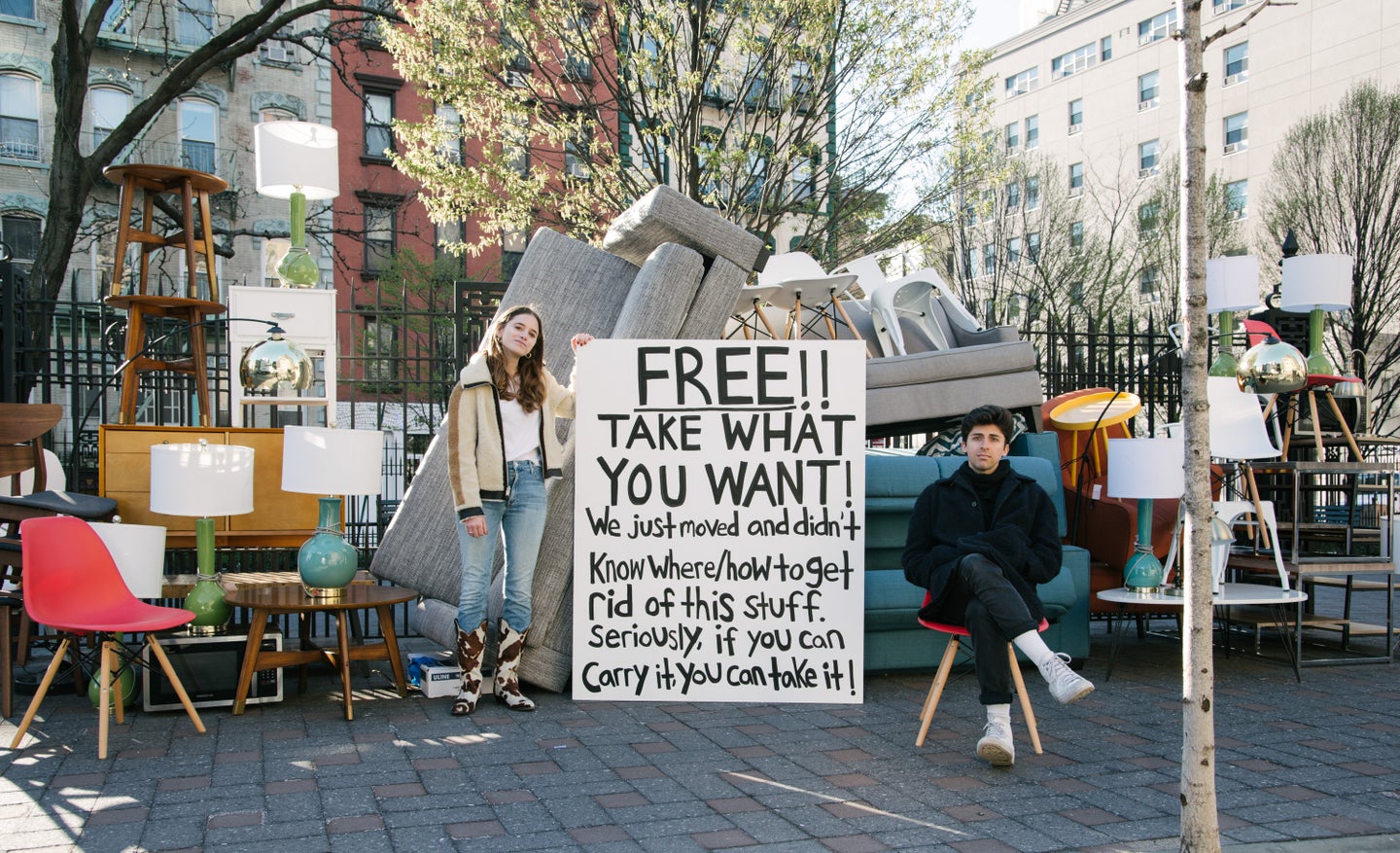Heads-Up: The Furniture You Tossed to the Curb Might Just Become a Work of Art
A new installation tackles the issue of disposable home furnishings.
Updated Oct 11, 2018 3:12 PM
We may earn revenue from the products available on this page and participate in affiliate programs.
You may be familiar with the term “fast fashion,” but have you ever considered the impact of “fast furniture”? In a new public art installation, “Take What You Want,” New York artists Matt Starr and Ellie Sachs are bringing awareness to the way people consume the things around their homes—from mattresses to sofas, to table lamps and more—and how they untimely dispose of them. That old chair you toss on the curb for garbage collection very well might become a part of their ever-changing installation, and for good reason.
“Ultimately, we wanted to say something about our obsession with material goods and our hazardous relationship with ‘stuff,’” Sachs says, “As a society, we’re buying and throwing things out at an alarming rate, and it’s taking a huge toll on the environment. Furniture is no different and is a massive contributor as a category.”
This project, produced in partnership with rental furniture company Feather, was inspired by their own experiences: Starr and Sachs recently moved apartments and realized that not all their larger household items would fit into their new place. They had no luck reselling on Facebook Marketplace and Craigslist and were turned away from their local consignment store, as it was already at capacity. Looking into this issue more, they soon learned that a lot of their pieces weren’t even recyclable and convenient alternative solutions were scarce. The reason it’s so common to see bulky furniture tossed on city curbs now became much more apparent to them.
With their installation, the two hope to make viewers become a bit more conscious about the furniture they discard and therefore more thoughtful about the home furnishings they purchase in the first place. “When something becomes so ubiquitous that you stop noticing it, it becomes normalized,” says Sachs, “We don’t want people to think it’s normal or a good idea to just throw your furniture out on the street. We hope this project asks people to reconsider their relationship with stuff, in general, and furniture, in particular.”
So… what exactly is fast furniture?
With the recent popularity of Tidying Up with Marie Kondo on Netflix, the focus on the consumption and quality of clothing has increased. As a result, this has triggered a rise in donations to local thrift stores and the talk of sustainability in fashion. However, furniture comparatively has not been given this same amount of attention.
“Because we don’t buy furniture on a daily basis like clothes, we don’t realize how much it’s affecting the environment,” says Starr, “But here are a few facts to note that we learned in our research: Furniture is the least-recycled household item and furniture is the second largest portion of urban waste. It’s made of cheap materials that aren’t meant to last, and its limited life span means increased waste in landfills.” And exactly how much furniture is in landfills across the country? According to the United States EPA, a staggering quantity of over 9 million tons.
How many times have you moved into an apartment only to buy new, cheap furniture that you eventually toss once your lease is up? If this rings familiar, you’re not alone. According to research, 50,000 mattresses alone end up in US landfills each day, putting a strain on the country’s recycling system and causing negative effects on our environment.
How to lessen your impact
Thankfully, there are simple ways we can lessen the impact that furniture and other larger household items may have on our world. The first step? We have to make conscious choices and become more aware of how and what we buy.
“There are great alternatives to the cheap stuff,” Sachs shares, “Consider buying furniture that is an investment, buying vintage pieces, or [renting] it.” Sachs and Starr also urge people to keep in mind the three R’s: reduce, reuse, and recycle. “Recycle is technically the last measure,” adds Sachs, “I think we need to do a better job of reducing waste and reusing things that can be reused and also not buying things that are meant to be disposed of.”
“Take What You Want” was publicly displayed on April 16 in downtown New York City on the corner of Lafayette Street and Kenmare Streets, and by the end of the day, yes, all the furniture was taken to new homes. Be sure to follow along with Sachs and Starr to get updated information on where their installations will be heading next—and remember: Whenever possible, don’t just toss your stuff to the curb.
See more on sustainability: IKEA’s New Tänkvärd Collection Embraces Sustainability and Bold Patterns A Small-Space Living Expert Puts a Stylish Spin on Sustainability Good News: You Already Have Everything You Need to Live a Sustainable Life
